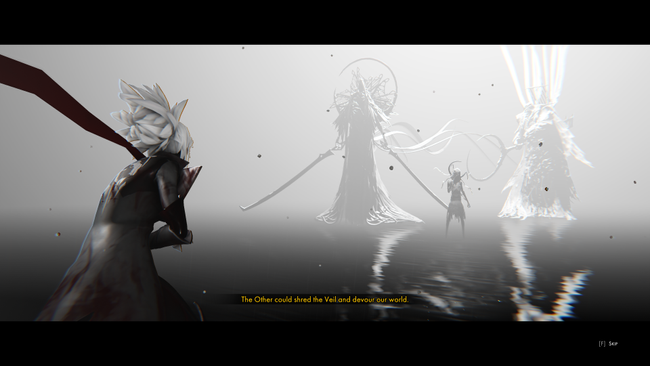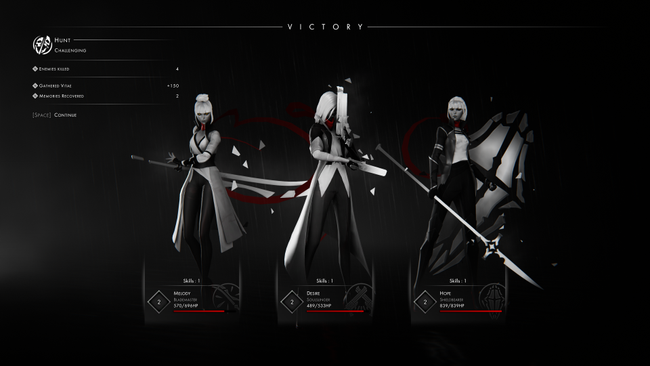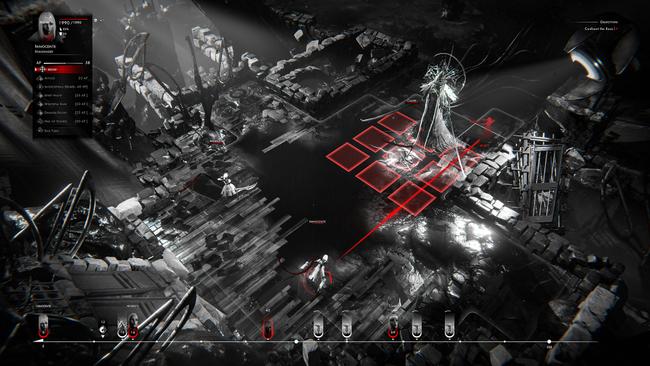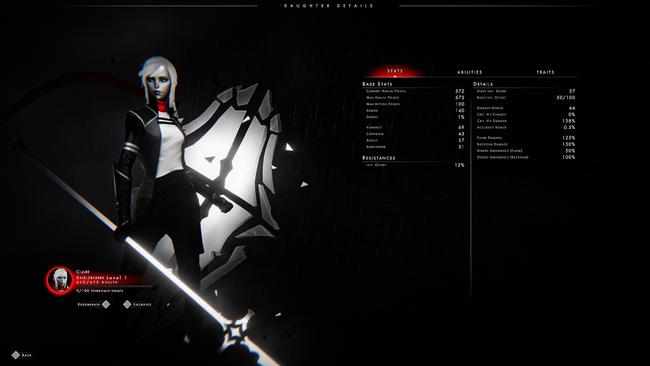
Othercide Review
Othercide certainly leaves an immediately memorable first impression. With its moody monochromatic art style and red accents, it certainly lingered in my mind when I first saw it about a year ago. I'm always on the lookout for good tactical RPGs, and this one certainly seemed it wanted to try something a little different than the usual. And it does, to varying degrees of success.
Don't expect the game to make a lot of sense when you first boot it up, however. You take control of a character only referred to as 'The Mother', and for some reason, you are battling nightmarish creatures in a bleak city-hellscape sort of place. The Mother falls, but she can still give rise to a limitless number of Daughters to do battle for her. You'll learn soon enough that you are trying to save 'The Child' from something called 'Suffering', but most of this is told through enigmatic statements & murmurs more than anything else.

Othercide does not have an outwardly straightforward A-to-B type narrative. There is no significant amount of plain exposition to explain what is going on in any specific sense. What the game has instead is a mix of vague statements made by the Mother, some brief initially-confusing dialogue cutscenes, and a codex in the game's menu. Oddly enough, some of the most elucidating bits of story info come from snippets of background information found in loading screens. It's certainly an interesting method to telling a story, and I did quite appreciate how it was trying to tell it. Just be aware you have to dedicate some time at first before things start to fall into place.
This is a tactical RPG at heart. However, one thing that was perhaps not immediately clear in the game's marketing up to release is that Othercide is also strongly a roguelike game. This means you effectively progress as far as you can with your cast of Daughters, eventually fail, and then you reset from the beginning. Don't worry, though, there are plenty of persistent elements in place which allow your team of Daughters to be more capable the next time through.
Starting out, your Daughters can be one of three different types: a melee-focused swordswoman, a defense-focused shieldbearer, or support-focused gunslinger, with a 4th scythe-wielding class coming about half-way through the game. Battles are on a smaller scale compared to most other tactical RPGs, with nearly every skirmish only allowing you to bring just 2-4 units. There are no real bespoke encounters or maps either. Instead, the game allows you to pick a type of battle from a list of options.

There are a few different encounter types, each with a different objective. Hunts task you with just taking out all the enemies on the map, Survival maps force you to simply survive long enough for a certain amount of time against waves of enemies, Rescue missions have you escorting a frail unit to a finish line, and so on. Unfortunately, this type of battle structure does get a little bit repetitive, especially in a roguelike-styled game where you'll inevitably have to restart from the beginning more than once. You find yourself sortieing to the same maps numerous times, with maybe just a few slight differences in enemy positioning.
The direct tactical gameplay itself is pretty well put together, with a fair amount of intricacies without being too overwrought. There is a good combination of direct attack skills, interrupt skills, buffs, and more that have to be considered in order to be effective in battle. Each character type (sword, gun, etc) can also choose from a few various abilities at certain levels, meaning that two different Daughters with the same weapon can be built to have somewhat different utility in combat. For example, one of my gunners specialized in doing as much damage from long-range as possible, while the other primarily stuck to support skills.
What makes Othercide a bit different than most other tactical RPGs is that it doesn't use a rigid turn order in combat. It's still turn-based, but instead, actions are dictated by a timeline system. The timeline shows 100 'initiative units', a unit's upcoming turn will slide along the timeline until it reaches 0, and then you can act (think a little bit like Grandia, here). Certain abilities will sometimes attack with a delay, which will be shown on the timeline when it will take place. There are, of course, plenty of abilities that can either boost or delay upcoming turns on the timeline as well, and sometimes shuffling turns around in this manner can be incredibly important to be successful.
Otherside also uses an AP system, where both movements and actions cost a certain value, and you only get so much AP to spend each turn. Another interesting wrinkle is that if you use only about half your total AP in a given turn, your next turn will come around sooner. Sometimes it's worth spending all your AP in order to deal as many attacks in a single turn as possible, and sometimes you'll want to make sure you stay under that half-threshold because getting another turn sooner is more important. It's just a small decision you'll have to make very frequently, but it leads to some thoughtful considerations that'll you'll have to balance, especially when it comes to boss encounters.

Bosses in Othercide are probably the gameplay highlight. There are 6 total bosses in the game, and each works a little bit like a puzzle. They usually have some certain pattern they follow in terms of which attacks they'll do in order, which of your Daughters they'll focus on, different phases with new patterns, and other gimmicks. Even if your Daughters have been built to be incredibly strong, attack in the wrong way and you'll going to end up making things harder for yourself. Even once you figure out 'how' to take on a boss, there's still a fair amount of execution required by the player if you want to take them out without getting beat up too much.
Enemies can drop items known as Memories, which ultimately work as the game's only sort of 'equipment'. Memories can add a variety of abilities to your Daughters' skills, such as increasing their attack power, delaying the enemy's turn, and more. Personally, I found that putting skills which lower enemy defense combined well with interrupt skills, as it would be my turn next and then I'd be able to dish out more damage.
These Memories not only act as stat-boosting accessories but also unlock The Mother's backstory within the game's codex. There's actually some reasonably well-written prose hidden throughout the codex within the menus, and it clarifies a lot about the game's overall premise. It does feel a bit divorced from the rest of the game, though, despite how much light it sheds on the narrative.

The strangest thing about playing Othercide is that it feels like not all the mechanics come together well, specifically when it comes to the game's supporting systems. For example, there is a currency called Vitae, which is used to attach Memories to your Daughters or used to germinate new Daughters. Being frank, I always had way more Vitae than I knew what to do with; I never played attention to costs for anything, because I always had plenty. Not to mention, the game's ability to germinate new Daughters is kind of a useless mechanic in its own right. You are better off reviving Daughters you already had rather than getting brand new ones. Reviving a daughter does require a special item, but you can usually get these fairly easily as well. Though, it's not as much of a gimme as the other currencies.
As a roguelike, there is a system in place where you can transfer bonus characteristics to future playthroughs, such that your Daughters will be stronger the next time through. There is a currency in place here as well, but once again, it's almost meaningless because you'll always have enough to choose every bonus you've unlocked.
Another system in place that is slightly awkwardly implemented is that of Sacrifice. This is a mechanic where you can sacrifice one Daughter to heal another. This is important to note: there is no other way to heal your Daughters in the game (it wouldn't be much of a roguelike if you could heal easily). This means that it is important not only to be victorious but ultimately to avoid taking damage as often as possible, for as long as possible. However, the sacrifice has to be at the same level or higher.

This system doesn't really make practical sense, in some ways. If you have a unit that is worth healing, chances are they are a high level, to begin with. If you have another unit capable of being a sacrifice, that means they are at least the same level or better. You have to get rid of one probably-good unit to heal your other almost-dead good unit. Notably, whenever a Daughter is sacrificed, they leave a little bit of a bonus passive boost behind. If you have a revive coin on hand, you might as well have the character sacrificed, get the passive boost, and then immediately revive them. In fact, it might be worth experimenting with the game systems to sacrifice Daughters cyclically, and continually revive them to stack up these passive boosts. I didn't try this out, although writing about it now I kinda wish I did to see how well this strategy works.
Additionally, some skills cost HP to use instead of AP, which can be useful in certain battles such as boss encounters. However, thanks to the scarcity of HP healing, I found it often wasn't worth actually using these skills in the long run. The cost of a strictly limited HP pool - rather than an AP pool that refreshes every turn - was just too high to make these skills actually worth using, more often than not.
A big problem for Othercide right now - that hopefully doesn't stick around for too long - is that it is missing a considerable level of polish. The UI is fairly awkward in numerous places, partially due to the monochromatic artstyle, and it takes a bit of getting used to how it displays to all the information it is trying to show. Some of the English localization (from French) is also a little bit awkward in trying to parse what exactly skills are actually doing, although you'll eventually get the hang of things through trial & error. Gamepad control is not immediately intuitive in how you sift through the various interfaces, especially in battle. There is a sped-up 'turbo' type function, which is great when it doubles animation speed if you are trying to get through a battle quickly. However, it also seemed to double my controller sensitivity, which made actually using the turbo mode a little bit of a nuisance.
My time with Othercide also came with numerous bugs. The development team at Lightbulb Crew is already aware of many of these issues and has been open about them, so hopefully it doesn't take too long for things to shape up. No individual bug is too problematic on its own, but encountering many numerous glitches cumulatively dampened my experience. The user interface would bug out in various ways, reordering how skills were displayed or how enemy ranges would appear. Sometimes enemies were just invisible. Sometimes icons of incoming enemy attacks would remain on the field even if the enemy was vanquished. The game also kept telling me my units leveled up after every single battle. To top it all off, I lost my completed save file seemingly due to a bug, which isn't fun.
Othercide is an interesting twist on the tactical RPG genre with a striking artstyle, adding in roguelike elements to questionable effect. Not everything comes together well mechanically, it's a little bit repetitive, and I think the narrative elements could have benefitted from just a tad more outward direction. It's certainly a unique game, which may be worth checking it out if you like trying new and different styles even if the execution is spotty in places.